Application of pedagogical principle Assignment 2022
VerifiedAdded on 2022/03/08
|15
|4179
|36
Assignment
AI Summary
Contribute Materials
Your contribution can guide someone’s learning journey. Share your
documents today.
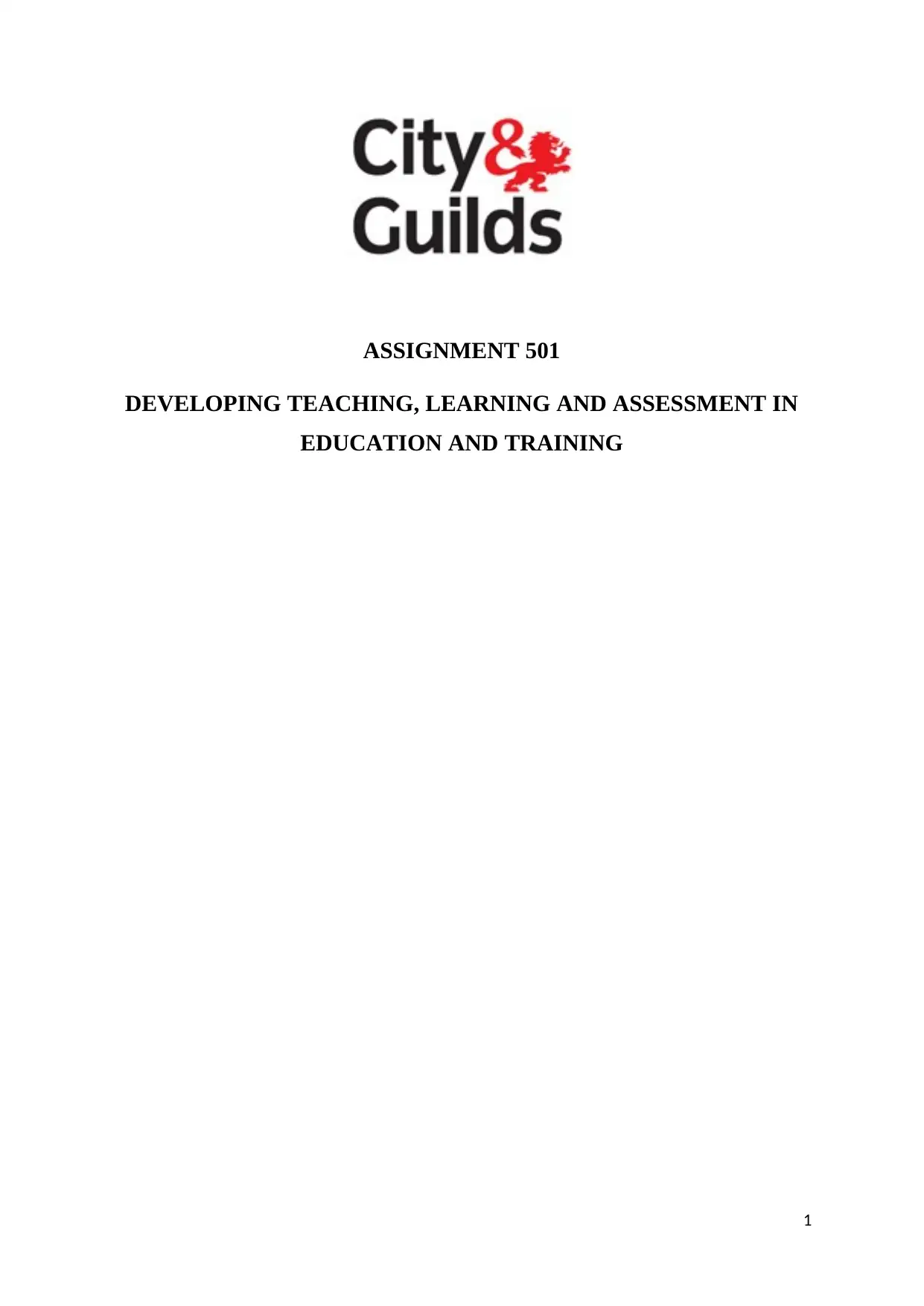
ASSIGNMENT 501
DEVELOPING TEACHING, LEARNING AND ASSESSMENT IN
EDUCATION AND TRAINING
1
DEVELOPING TEACHING, LEARNING AND ASSESSMENT IN
EDUCATION AND TRAINING
1
Secure Best Marks with AI Grader
Need help grading? Try our AI Grader for instant feedback on your assignments.
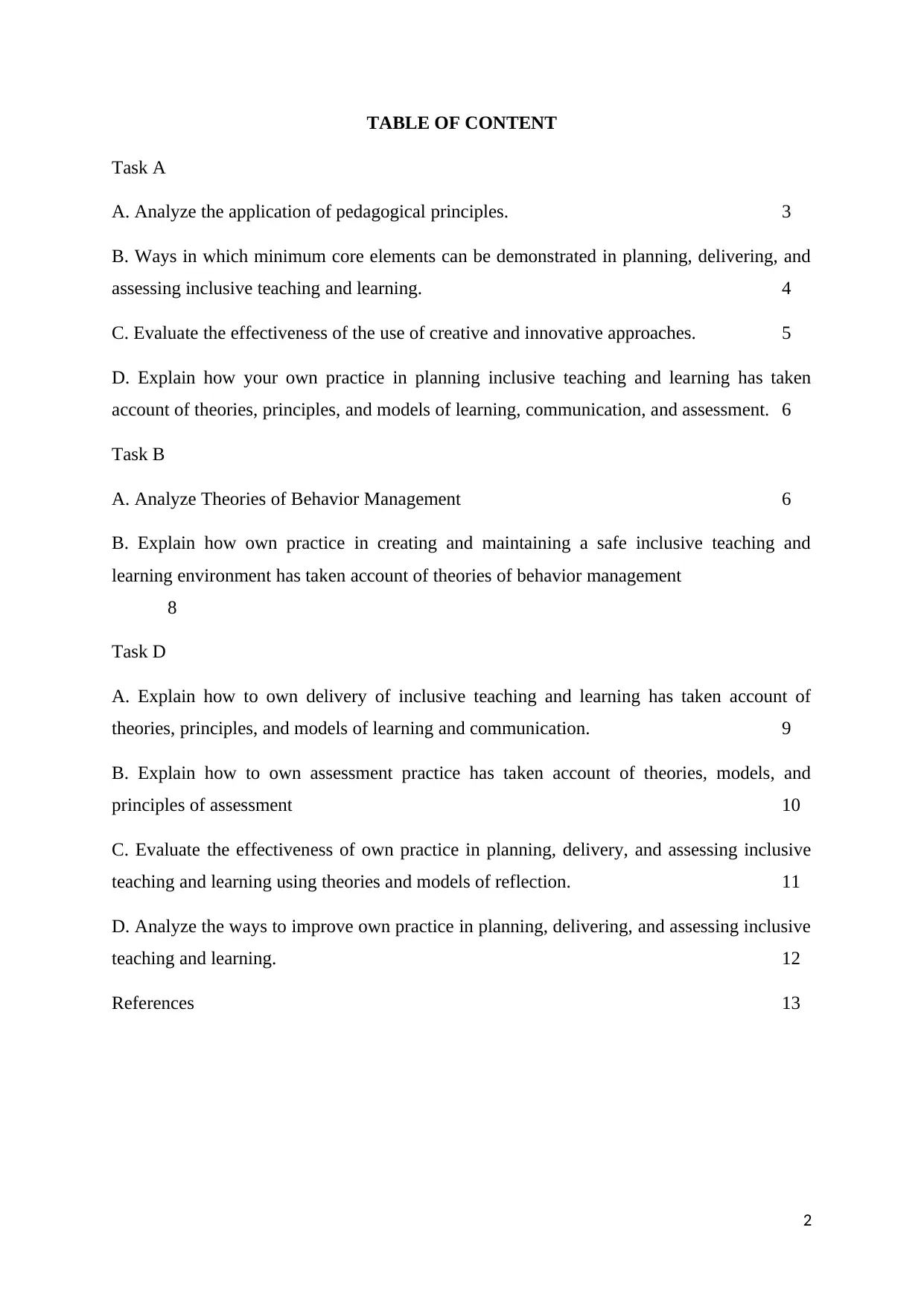
TABLE OF CONTENT
Task A
A. Analyze the application of pedagogical principles. 3
B. Ways in which minimum core elements can be demonstrated in planning, delivering, and
assessing inclusive teaching and learning. 4
C. Evaluate the effectiveness of the use of creative and innovative approaches. 5
D. Explain how your own practice in planning inclusive teaching and learning has taken
account of theories, principles, and models of learning, communication, and assessment. 6
Task B
A. Analyze Theories of Behavior Management 6
B. Explain how own practice in creating and maintaining a safe inclusive teaching and
learning environment has taken account of theories of behavior management
8
Task D
A. Explain how to own delivery of inclusive teaching and learning has taken account of
theories, principles, and models of learning and communication. 9
B. Explain how to own assessment practice has taken account of theories, models, and
principles of assessment 10
C. Evaluate the effectiveness of own practice in planning, delivery, and assessing inclusive
teaching and learning using theories and models of reflection. 11
D. Analyze the ways to improve own practice in planning, delivering, and assessing inclusive
teaching and learning. 12
References 13
2
Task A
A. Analyze the application of pedagogical principles. 3
B. Ways in which minimum core elements can be demonstrated in planning, delivering, and
assessing inclusive teaching and learning. 4
C. Evaluate the effectiveness of the use of creative and innovative approaches. 5
D. Explain how your own practice in planning inclusive teaching and learning has taken
account of theories, principles, and models of learning, communication, and assessment. 6
Task B
A. Analyze Theories of Behavior Management 6
B. Explain how own practice in creating and maintaining a safe inclusive teaching and
learning environment has taken account of theories of behavior management
8
Task D
A. Explain how to own delivery of inclusive teaching and learning has taken account of
theories, principles, and models of learning and communication. 9
B. Explain how to own assessment practice has taken account of theories, models, and
principles of assessment 10
C. Evaluate the effectiveness of own practice in planning, delivery, and assessing inclusive
teaching and learning using theories and models of reflection. 11
D. Analyze the ways to improve own practice in planning, delivering, and assessing inclusive
teaching and learning. 12
References 13
2
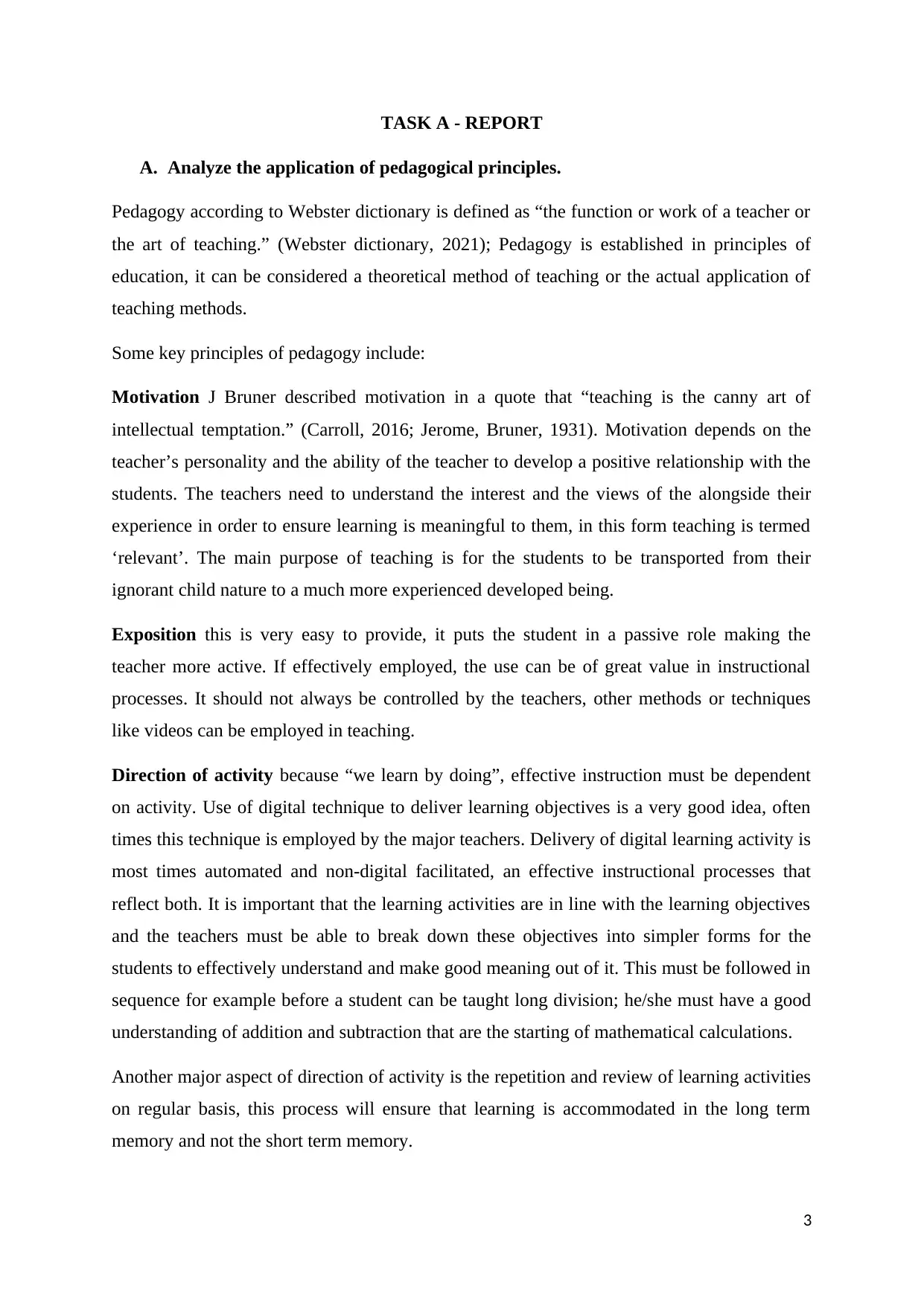
TASK A - REPORT
A. Analyze the application of pedagogical principles.
Pedagogy according to Webster dictionary is defined as “the function or work of a teacher or
the art of teaching.” (Webster dictionary, 2021); Pedagogy is established in principles of
education, it can be considered a theoretical method of teaching or the actual application of
teaching methods.
Some key principles of pedagogy include:
Motivation J Bruner described motivation in a quote that “teaching is the canny art of
intellectual temptation.” (Carroll, 2016; Jerome, Bruner, 1931). Motivation depends on the
teacher’s personality and the ability of the teacher to develop a positive relationship with the
students. The teachers need to understand the interest and the views of the alongside their
experience in order to ensure learning is meaningful to them, in this form teaching is termed
‘relevant’. The main purpose of teaching is for the students to be transported from their
ignorant child nature to a much more experienced developed being.
Exposition this is very easy to provide, it puts the student in a passive role making the
teacher more active. If effectively employed, the use can be of great value in instructional
processes. It should not always be controlled by the teachers, other methods or techniques
like videos can be employed in teaching.
Direction of activity because “we learn by doing”, effective instruction must be dependent
on activity. Use of digital technique to deliver learning objectives is a very good idea, often
times this technique is employed by the major teachers. Delivery of digital learning activity is
most times automated and non-digital facilitated, an effective instructional processes that
reflect both. It is important that the learning activities are in line with the learning objectives
and the teachers must be able to break down these objectives into simpler forms for the
students to effectively understand and make good meaning out of it. This must be followed in
sequence for example before a student can be taught long division; he/she must have a good
understanding of addition and subtraction that are the starting of mathematical calculations.
Another major aspect of direction of activity is the repetition and review of learning activities
on regular basis, this process will ensure that learning is accommodated in the long term
memory and not the short term memory.
3
A. Analyze the application of pedagogical principles.
Pedagogy according to Webster dictionary is defined as “the function or work of a teacher or
the art of teaching.” (Webster dictionary, 2021); Pedagogy is established in principles of
education, it can be considered a theoretical method of teaching or the actual application of
teaching methods.
Some key principles of pedagogy include:
Motivation J Bruner described motivation in a quote that “teaching is the canny art of
intellectual temptation.” (Carroll, 2016; Jerome, Bruner, 1931). Motivation depends on the
teacher’s personality and the ability of the teacher to develop a positive relationship with the
students. The teachers need to understand the interest and the views of the alongside their
experience in order to ensure learning is meaningful to them, in this form teaching is termed
‘relevant’. The main purpose of teaching is for the students to be transported from their
ignorant child nature to a much more experienced developed being.
Exposition this is very easy to provide, it puts the student in a passive role making the
teacher more active. If effectively employed, the use can be of great value in instructional
processes. It should not always be controlled by the teachers, other methods or techniques
like videos can be employed in teaching.
Direction of activity because “we learn by doing”, effective instruction must be dependent
on activity. Use of digital technique to deliver learning objectives is a very good idea, often
times this technique is employed by the major teachers. Delivery of digital learning activity is
most times automated and non-digital facilitated, an effective instructional processes that
reflect both. It is important that the learning activities are in line with the learning objectives
and the teachers must be able to break down these objectives into simpler forms for the
students to effectively understand and make good meaning out of it. This must be followed in
sequence for example before a student can be taught long division; he/she must have a good
understanding of addition and subtraction that are the starting of mathematical calculations.
Another major aspect of direction of activity is the repetition and review of learning activities
on regular basis, this process will ensure that learning is accommodated in the long term
memory and not the short term memory.
3
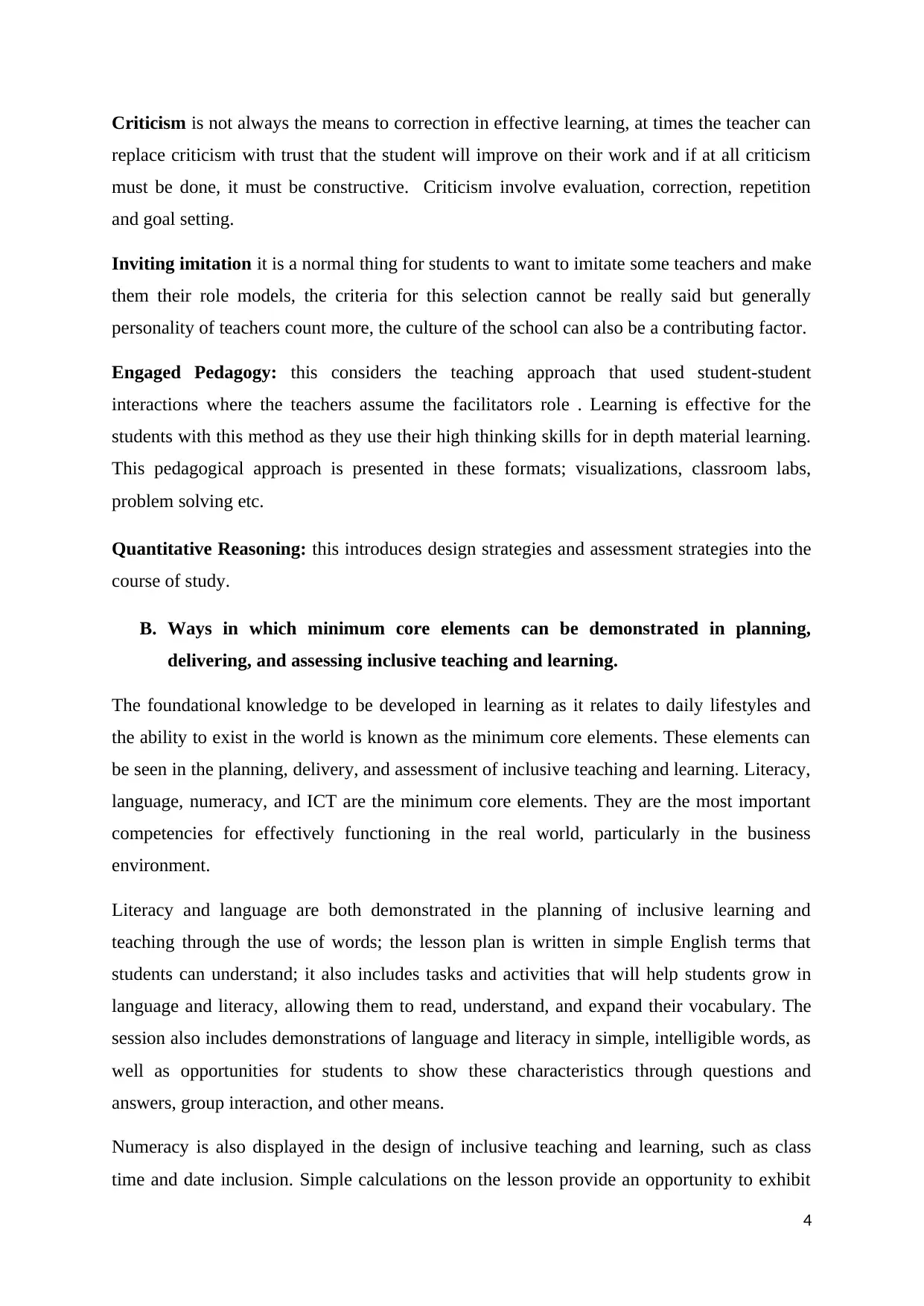
Criticism is not always the means to correction in effective learning, at times the teacher can
replace criticism with trust that the student will improve on their work and if at all criticism
must be done, it must be constructive. Criticism involve evaluation, correction, repetition
and goal setting.
Inviting imitation it is a normal thing for students to want to imitate some teachers and make
them their role models, the criteria for this selection cannot be really said but generally
personality of teachers count more, the culture of the school can also be a contributing factor.
Engaged Pedagogy: this considers the teaching approach that used student-student
interactions where the teachers assume the facilitators role . Learning is effective for the
students with this method as they use their high thinking skills for in depth material learning.
This pedagogical approach is presented in these formats; visualizations, classroom labs,
problem solving etc.
Quantitative Reasoning: this introduces design strategies and assessment strategies into the
course of study.
B. Ways in which minimum core elements can be demonstrated in planning,
delivering, and assessing inclusive teaching and learning.
The foundational knowledge to be developed in learning as it relates to daily lifestyles and
the ability to exist in the world is known as the minimum core elements. These elements can
be seen in the planning, delivery, and assessment of inclusive teaching and learning. Literacy,
language, numeracy, and ICT are the minimum core elements. They are the most important
competencies for effectively functioning in the real world, particularly in the business
environment.
Literacy and language are both demonstrated in the planning of inclusive learning and
teaching through the use of words; the lesson plan is written in simple English terms that
students can understand; it also includes tasks and activities that will help students grow in
language and literacy, allowing them to read, understand, and expand their vocabulary. The
session also includes demonstrations of language and literacy in simple, intelligible words, as
well as opportunities for students to show these characteristics through questions and
answers, group interaction, and other means.
Numeracy is also displayed in the design of inclusive teaching and learning, such as class
time and date inclusion. Simple calculations on the lesson provide an opportunity to exhibit
4
replace criticism with trust that the student will improve on their work and if at all criticism
must be done, it must be constructive. Criticism involve evaluation, correction, repetition
and goal setting.
Inviting imitation it is a normal thing for students to want to imitate some teachers and make
them their role models, the criteria for this selection cannot be really said but generally
personality of teachers count more, the culture of the school can also be a contributing factor.
Engaged Pedagogy: this considers the teaching approach that used student-student
interactions where the teachers assume the facilitators role . Learning is effective for the
students with this method as they use their high thinking skills for in depth material learning.
This pedagogical approach is presented in these formats; visualizations, classroom labs,
problem solving etc.
Quantitative Reasoning: this introduces design strategies and assessment strategies into the
course of study.
B. Ways in which minimum core elements can be demonstrated in planning,
delivering, and assessing inclusive teaching and learning.
The foundational knowledge to be developed in learning as it relates to daily lifestyles and
the ability to exist in the world is known as the minimum core elements. These elements can
be seen in the planning, delivery, and assessment of inclusive teaching and learning. Literacy,
language, numeracy, and ICT are the minimum core elements. They are the most important
competencies for effectively functioning in the real world, particularly in the business
environment.
Literacy and language are both demonstrated in the planning of inclusive learning and
teaching through the use of words; the lesson plan is written in simple English terms that
students can understand; it also includes tasks and activities that will help students grow in
language and literacy, allowing them to read, understand, and expand their vocabulary. The
session also includes demonstrations of language and literacy in simple, intelligible words, as
well as opportunities for students to show these characteristics through questions and
answers, group interaction, and other means.
Numeracy is also displayed in the design of inclusive teaching and learning, such as class
time and date inclusion. Simple calculations on the lesson provide an opportunity to exhibit
4
Secure Best Marks with AI Grader
Need help grading? Try our AI Grader for instant feedback on your assignments.
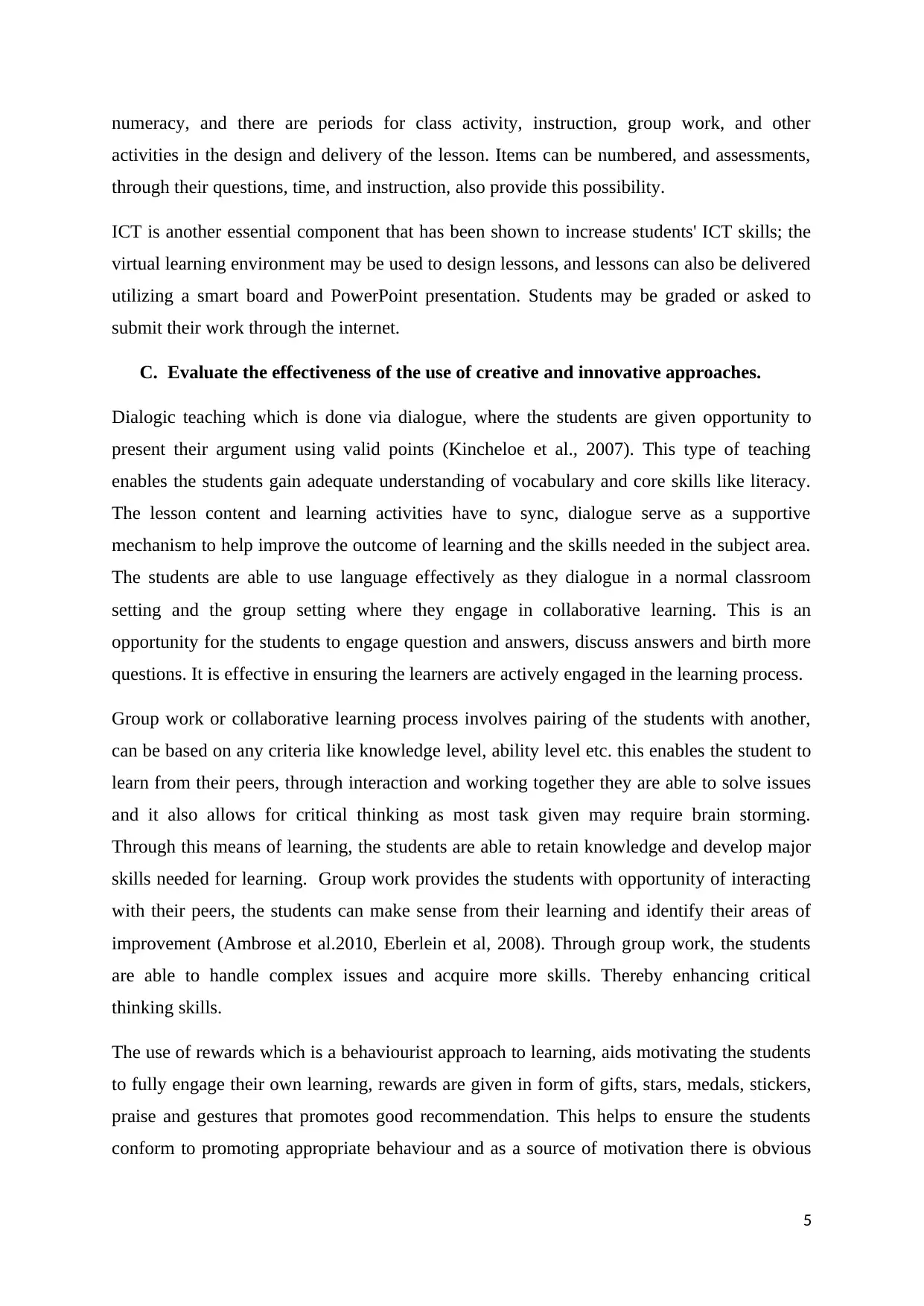
numeracy, and there are periods for class activity, instruction, group work, and other
activities in the design and delivery of the lesson. Items can be numbered, and assessments,
through their questions, time, and instruction, also provide this possibility.
ICT is another essential component that has been shown to increase students' ICT skills; the
virtual learning environment may be used to design lessons, and lessons can also be delivered
utilizing a smart board and PowerPoint presentation. Students may be graded or asked to
submit their work through the internet.
C. Evaluate the effectiveness of the use of creative and innovative approaches.
Dialogic teaching which is done via dialogue, where the students are given opportunity to
present their argument using valid points (Kincheloe et al., 2007). This type of teaching
enables the students gain adequate understanding of vocabulary and core skills like literacy.
The lesson content and learning activities have to sync, dialogue serve as a supportive
mechanism to help improve the outcome of learning and the skills needed in the subject area.
The students are able to use language effectively as they dialogue in a normal classroom
setting and the group setting where they engage in collaborative learning. This is an
opportunity for the students to engage question and answers, discuss answers and birth more
questions. It is effective in ensuring the learners are actively engaged in the learning process.
Group work or collaborative learning process involves pairing of the students with another,
can be based on any criteria like knowledge level, ability level etc. this enables the student to
learn from their peers, through interaction and working together they are able to solve issues
and it also allows for critical thinking as most task given may require brain storming.
Through this means of learning, the students are able to retain knowledge and develop major
skills needed for learning. Group work provides the students with opportunity of interacting
with their peers, the students can make sense from their learning and identify their areas of
improvement (Ambrose et al.2010, Eberlein et al, 2008). Through group work, the students
are able to handle complex issues and acquire more skills. Thereby enhancing critical
thinking skills.
The use of rewards which is a behaviourist approach to learning, aids motivating the students
to fully engage their own learning, rewards are given in form of gifts, stars, medals, stickers,
praise and gestures that promotes good recommendation. This helps to ensure the students
conform to promoting appropriate behaviour and as a source of motivation there is obvious
5
activities in the design and delivery of the lesson. Items can be numbered, and assessments,
through their questions, time, and instruction, also provide this possibility.
ICT is another essential component that has been shown to increase students' ICT skills; the
virtual learning environment may be used to design lessons, and lessons can also be delivered
utilizing a smart board and PowerPoint presentation. Students may be graded or asked to
submit their work through the internet.
C. Evaluate the effectiveness of the use of creative and innovative approaches.
Dialogic teaching which is done via dialogue, where the students are given opportunity to
present their argument using valid points (Kincheloe et al., 2007). This type of teaching
enables the students gain adequate understanding of vocabulary and core skills like literacy.
The lesson content and learning activities have to sync, dialogue serve as a supportive
mechanism to help improve the outcome of learning and the skills needed in the subject area.
The students are able to use language effectively as they dialogue in a normal classroom
setting and the group setting where they engage in collaborative learning. This is an
opportunity for the students to engage question and answers, discuss answers and birth more
questions. It is effective in ensuring the learners are actively engaged in the learning process.
Group work or collaborative learning process involves pairing of the students with another,
can be based on any criteria like knowledge level, ability level etc. this enables the student to
learn from their peers, through interaction and working together they are able to solve issues
and it also allows for critical thinking as most task given may require brain storming.
Through this means of learning, the students are able to retain knowledge and develop major
skills needed for learning. Group work provides the students with opportunity of interacting
with their peers, the students can make sense from their learning and identify their areas of
improvement (Ambrose et al.2010, Eberlein et al, 2008). Through group work, the students
are able to handle complex issues and acquire more skills. Thereby enhancing critical
thinking skills.
The use of rewards which is a behaviourist approach to learning, aids motivating the students
to fully engage their own learning, rewards are given in form of gifts, stars, medals, stickers,
praise and gestures that promotes good recommendation. This helps to ensure the students
conform to promoting appropriate behaviour and as a source of motivation there is obvious
5
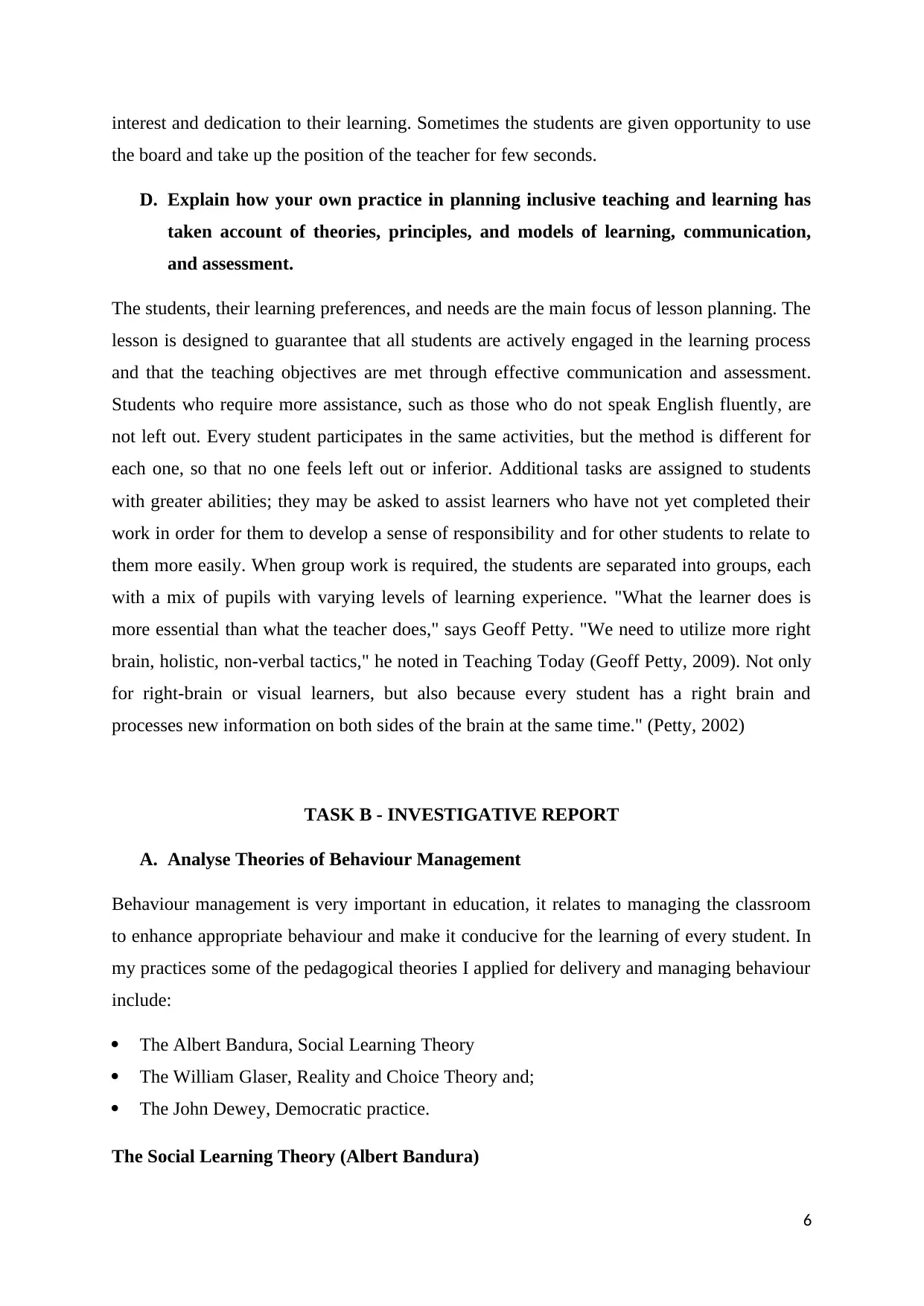
interest and dedication to their learning. Sometimes the students are given opportunity to use
the board and take up the position of the teacher for few seconds.
D. Explain how your own practice in planning inclusive teaching and learning has
taken account of theories, principles, and models of learning, communication,
and assessment.
The students, their learning preferences, and needs are the main focus of lesson planning. The
lesson is designed to guarantee that all students are actively engaged in the learning process
and that the teaching objectives are met through effective communication and assessment.
Students who require more assistance, such as those who do not speak English fluently, are
not left out. Every student participates in the same activities, but the method is different for
each one, so that no one feels left out or inferior. Additional tasks are assigned to students
with greater abilities; they may be asked to assist learners who have not yet completed their
work in order for them to develop a sense of responsibility and for other students to relate to
them more easily. When group work is required, the students are separated into groups, each
with a mix of pupils with varying levels of learning experience. "What the learner does is
more essential than what the teacher does," says Geoff Petty. "We need to utilize more right
brain, holistic, non-verbal tactics," he noted in Teaching Today (Geoff Petty, 2009). Not only
for right-brain or visual learners, but also because every student has a right brain and
processes new information on both sides of the brain at the same time." (Petty, 2002)
TASK B - INVESTIGATIVE REPORT
A. Analyse Theories of Behaviour Management
Behaviour management is very important in education, it relates to managing the classroom
to enhance appropriate behaviour and make it conducive for the learning of every student. In
my practices some of the pedagogical theories I applied for delivery and managing behaviour
include:
The Albert Bandura, Social Learning Theory
The William Glaser, Reality and Choice Theory and;
The John Dewey, Democratic practice.
The Social Learning Theory (Albert Bandura)
6
the board and take up the position of the teacher for few seconds.
D. Explain how your own practice in planning inclusive teaching and learning has
taken account of theories, principles, and models of learning, communication,
and assessment.
The students, their learning preferences, and needs are the main focus of lesson planning. The
lesson is designed to guarantee that all students are actively engaged in the learning process
and that the teaching objectives are met through effective communication and assessment.
Students who require more assistance, such as those who do not speak English fluently, are
not left out. Every student participates in the same activities, but the method is different for
each one, so that no one feels left out or inferior. Additional tasks are assigned to students
with greater abilities; they may be asked to assist learners who have not yet completed their
work in order for them to develop a sense of responsibility and for other students to relate to
them more easily. When group work is required, the students are separated into groups, each
with a mix of pupils with varying levels of learning experience. "What the learner does is
more essential than what the teacher does," says Geoff Petty. "We need to utilize more right
brain, holistic, non-verbal tactics," he noted in Teaching Today (Geoff Petty, 2009). Not only
for right-brain or visual learners, but also because every student has a right brain and
processes new information on both sides of the brain at the same time." (Petty, 2002)
TASK B - INVESTIGATIVE REPORT
A. Analyse Theories of Behaviour Management
Behaviour management is very important in education, it relates to managing the classroom
to enhance appropriate behaviour and make it conducive for the learning of every student. In
my practices some of the pedagogical theories I applied for delivery and managing behaviour
include:
The Albert Bandura, Social Learning Theory
The William Glaser, Reality and Choice Theory and;
The John Dewey, Democratic practice.
The Social Learning Theory (Albert Bandura)
6
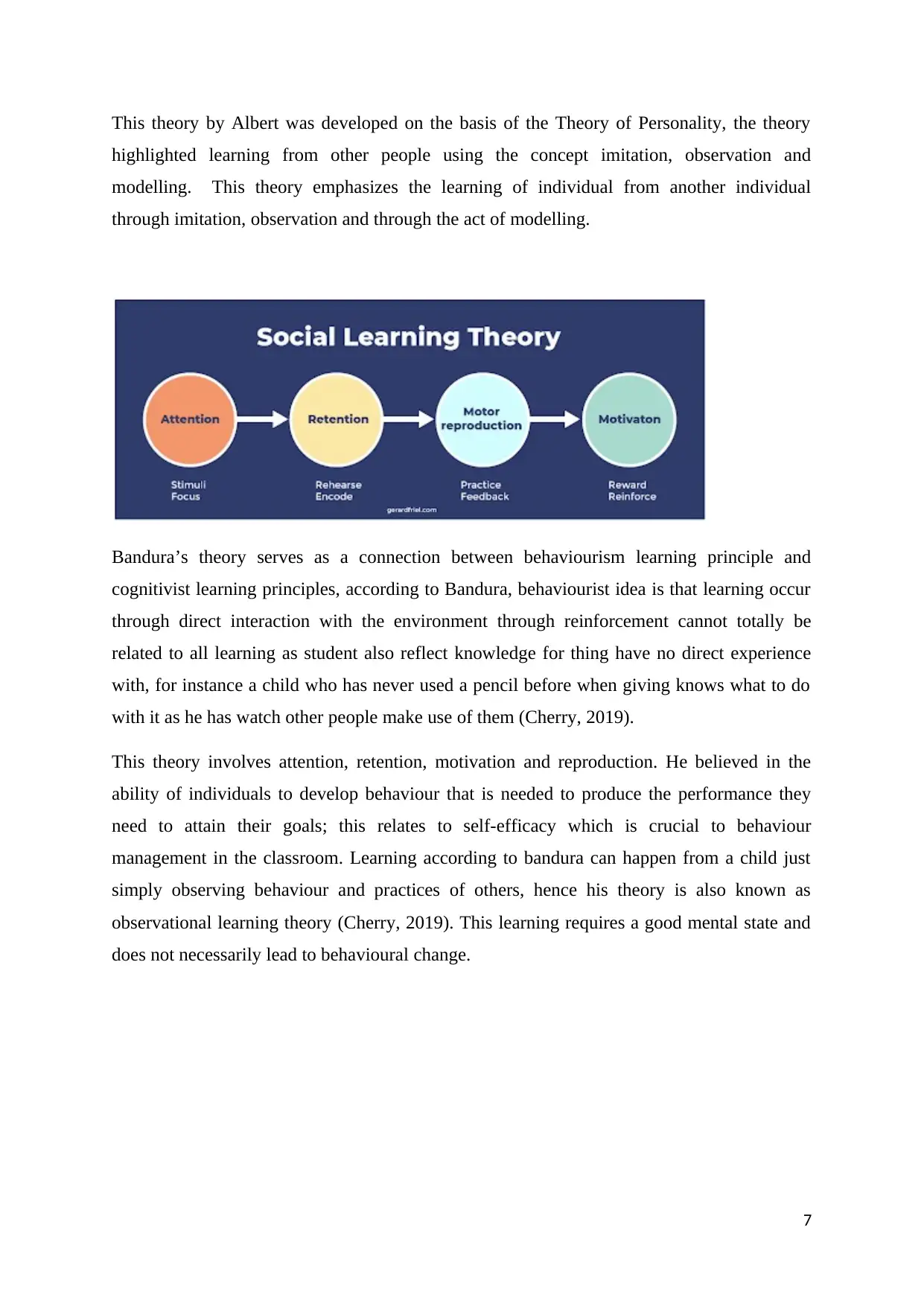
This theory by Albert was developed on the basis of the Theory of Personality, the theory
highlighted learning from other people using the concept imitation, observation and
modelling. This theory emphasizes the learning of individual from another individual
through imitation, observation and through the act of modelling.
Bandura’s theory serves as a connection between behaviourism learning principle and
cognitivist learning principles, according to Bandura, behaviourist idea is that learning occur
through direct interaction with the environment through reinforcement cannot totally be
related to all learning as student also reflect knowledge for thing have no direct experience
with, for instance a child who has never used a pencil before when giving knows what to do
with it as he has watch other people make use of them (Cherry, 2019).
This theory involves attention, retention, motivation and reproduction. He believed in the
ability of individuals to develop behaviour that is needed to produce the performance they
need to attain their goals; this relates to self-efficacy which is crucial to behaviour
management in the classroom. Learning according to bandura can happen from a child just
simply observing behaviour and practices of others, hence his theory is also known as
observational learning theory (Cherry, 2019). This learning requires a good mental state and
does not necessarily lead to behavioural change.
7
highlighted learning from other people using the concept imitation, observation and
modelling. This theory emphasizes the learning of individual from another individual
through imitation, observation and through the act of modelling.
Bandura’s theory serves as a connection between behaviourism learning principle and
cognitivist learning principles, according to Bandura, behaviourist idea is that learning occur
through direct interaction with the environment through reinforcement cannot totally be
related to all learning as student also reflect knowledge for thing have no direct experience
with, for instance a child who has never used a pencil before when giving knows what to do
with it as he has watch other people make use of them (Cherry, 2019).
This theory involves attention, retention, motivation and reproduction. He believed in the
ability of individuals to develop behaviour that is needed to produce the performance they
need to attain their goals; this relates to self-efficacy which is crucial to behaviour
management in the classroom. Learning according to bandura can happen from a child just
simply observing behaviour and practices of others, hence his theory is also known as
observational learning theory (Cherry, 2019). This learning requires a good mental state and
does not necessarily lead to behavioural change.
7
Paraphrase This Document
Need a fresh take? Get an instant paraphrase of this document with our AI Paraphraser
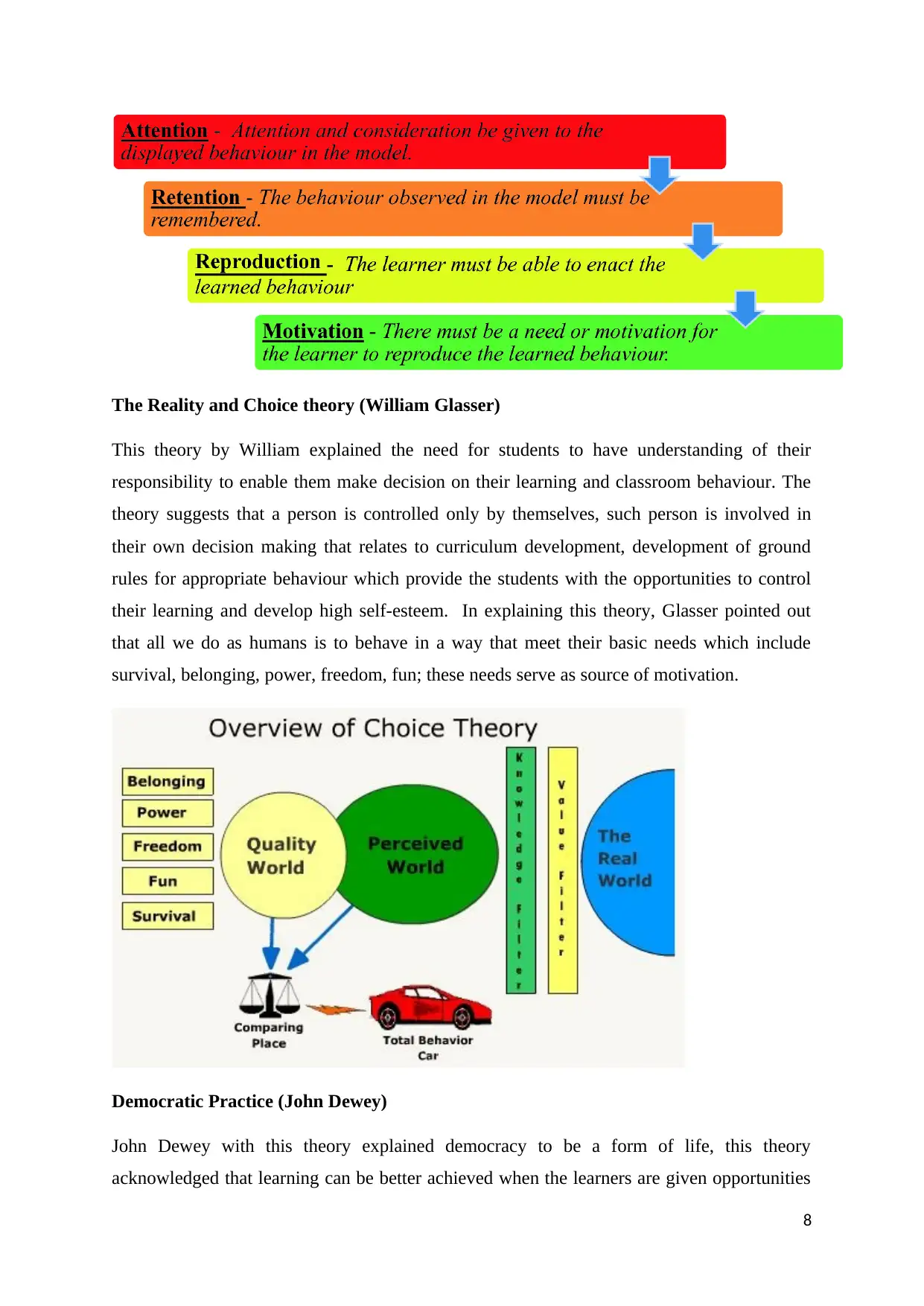
The Reality and Choice theory (William Glasser)
This theory by William explained the need for students to have understanding of their
responsibility to enable them make decision on their learning and classroom behaviour. The
theory suggests that a person is controlled only by themselves, such person is involved in
their own decision making that relates to curriculum development, development of ground
rules for appropriate behaviour which provide the students with the opportunities to control
their learning and develop high self-esteem. In explaining this theory, Glasser pointed out
that all we do as humans is to behave in a way that meet their basic needs which include
survival, belonging, power, freedom, fun; these needs serve as source of motivation.
Democratic Practice (John Dewey)
John Dewey with this theory explained democracy to be a form of life, this theory
acknowledged that learning can be better achieved when the learners are given opportunities
8
This theory by William explained the need for students to have understanding of their
responsibility to enable them make decision on their learning and classroom behaviour. The
theory suggests that a person is controlled only by themselves, such person is involved in
their own decision making that relates to curriculum development, development of ground
rules for appropriate behaviour which provide the students with the opportunities to control
their learning and develop high self-esteem. In explaining this theory, Glasser pointed out
that all we do as humans is to behave in a way that meet their basic needs which include
survival, belonging, power, freedom, fun; these needs serve as source of motivation.
Democratic Practice (John Dewey)
John Dewey with this theory explained democracy to be a form of life, this theory
acknowledged that learning can be better achieved when the learners are given opportunities
8
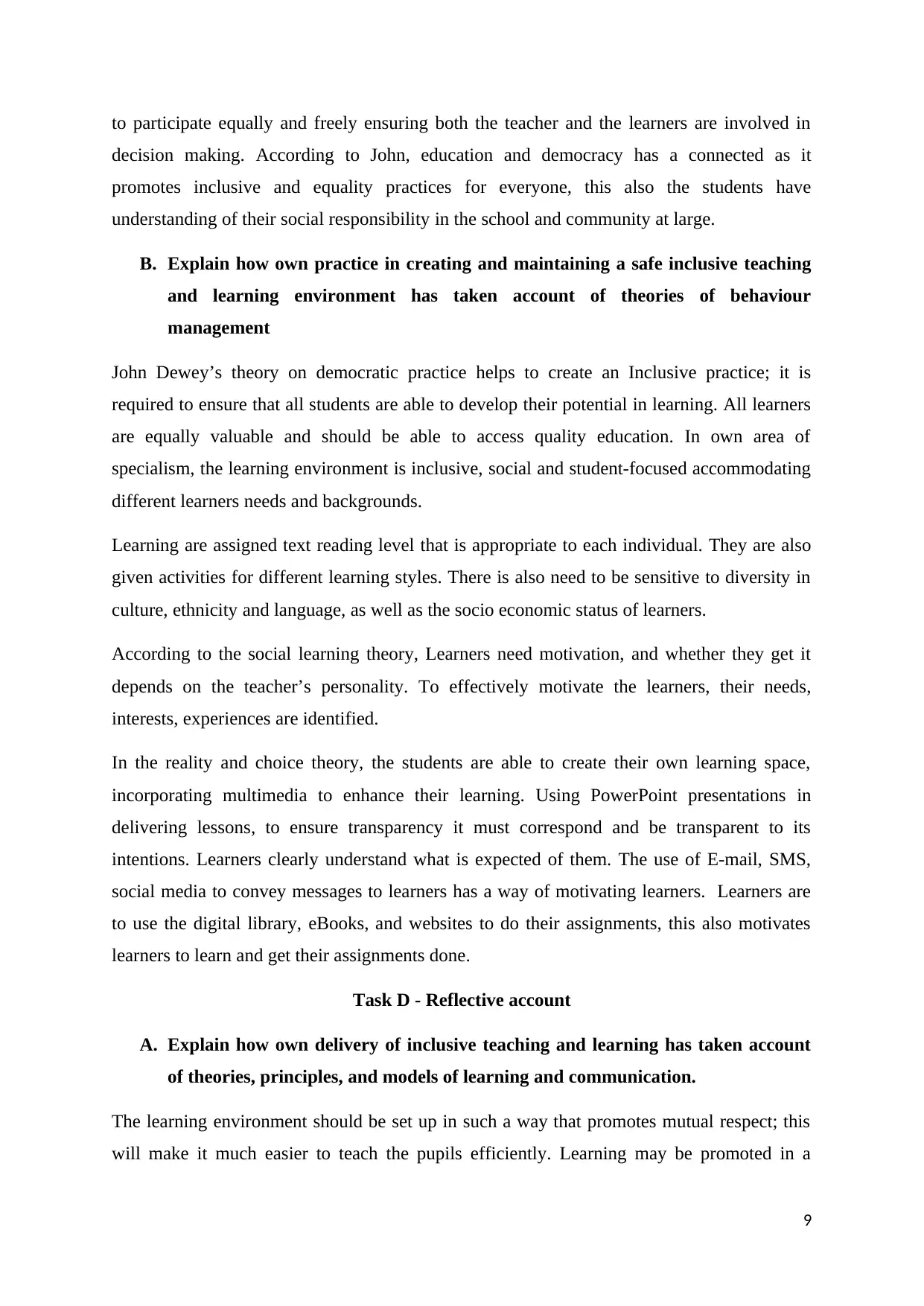
to participate equally and freely ensuring both the teacher and the learners are involved in
decision making. According to John, education and democracy has a connected as it
promotes inclusive and equality practices for everyone, this also the students have
understanding of their social responsibility in the school and community at large.
B. Explain how own practice in creating and maintaining a safe inclusive teaching
and learning environment has taken account of theories of behaviour
management
John Dewey’s theory on democratic practice helps to create an Inclusive practice; it is
required to ensure that all students are able to develop their potential in learning. All learners
are equally valuable and should be able to access quality education. In own area of
specialism, the learning environment is inclusive, social and student-focused accommodating
different learners needs and backgrounds.
Learning are assigned text reading level that is appropriate to each individual. They are also
given activities for different learning styles. There is also need to be sensitive to diversity in
culture, ethnicity and language, as well as the socio economic status of learners.
According to the social learning theory, Learners need motivation, and whether they get it
depends on the teacher’s personality. To effectively motivate the learners, their needs,
interests, experiences are identified.
In the reality and choice theory, the students are able to create their own learning space,
incorporating multimedia to enhance their learning. Using PowerPoint presentations in
delivering lessons, to ensure transparency it must correspond and be transparent to its
intentions. Learners clearly understand what is expected of them. The use of E-mail, SMS,
social media to convey messages to learners has a way of motivating learners. Learners are
to use the digital library, eBooks, and websites to do their assignments, this also motivates
learners to learn and get their assignments done.
Task D - Reflective account
A. Explain how own delivery of inclusive teaching and learning has taken account
of theories, principles, and models of learning and communication.
The learning environment should be set up in such a way that promotes mutual respect; this
will make it much easier to teach the pupils efficiently. Learning may be promoted in a
9
decision making. According to John, education and democracy has a connected as it
promotes inclusive and equality practices for everyone, this also the students have
understanding of their social responsibility in the school and community at large.
B. Explain how own practice in creating and maintaining a safe inclusive teaching
and learning environment has taken account of theories of behaviour
management
John Dewey’s theory on democratic practice helps to create an Inclusive practice; it is
required to ensure that all students are able to develop their potential in learning. All learners
are equally valuable and should be able to access quality education. In own area of
specialism, the learning environment is inclusive, social and student-focused accommodating
different learners needs and backgrounds.
Learning are assigned text reading level that is appropriate to each individual. They are also
given activities for different learning styles. There is also need to be sensitive to diversity in
culture, ethnicity and language, as well as the socio economic status of learners.
According to the social learning theory, Learners need motivation, and whether they get it
depends on the teacher’s personality. To effectively motivate the learners, their needs,
interests, experiences are identified.
In the reality and choice theory, the students are able to create their own learning space,
incorporating multimedia to enhance their learning. Using PowerPoint presentations in
delivering lessons, to ensure transparency it must correspond and be transparent to its
intentions. Learners clearly understand what is expected of them. The use of E-mail, SMS,
social media to convey messages to learners has a way of motivating learners. Learners are
to use the digital library, eBooks, and websites to do their assignments, this also motivates
learners to learn and get their assignments done.
Task D - Reflective account
A. Explain how own delivery of inclusive teaching and learning has taken account
of theories, principles, and models of learning and communication.
The learning environment should be set up in such a way that promotes mutual respect; this
will make it much easier to teach the pupils efficiently. Learning may be promoted in a
9
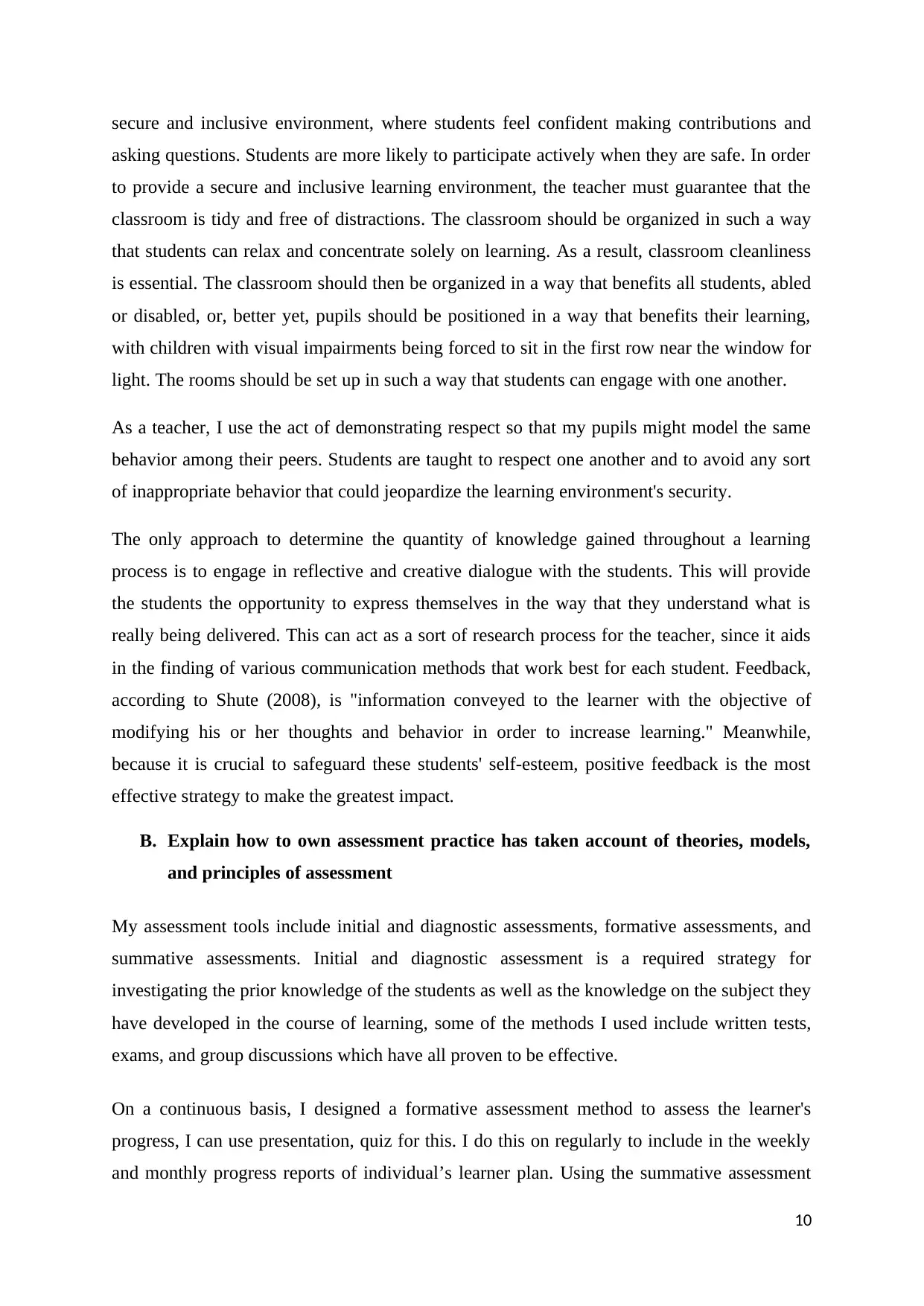
secure and inclusive environment, where students feel confident making contributions and
asking questions. Students are more likely to participate actively when they are safe. In order
to provide a secure and inclusive learning environment, the teacher must guarantee that the
classroom is tidy and free of distractions. The classroom should be organized in such a way
that students can relax and concentrate solely on learning. As a result, classroom cleanliness
is essential. The classroom should then be organized in a way that benefits all students, abled
or disabled, or, better yet, pupils should be positioned in a way that benefits their learning,
with children with visual impairments being forced to sit in the first row near the window for
light. The rooms should be set up in such a way that students can engage with one another.
As a teacher, I use the act of demonstrating respect so that my pupils might model the same
behavior among their peers. Students are taught to respect one another and to avoid any sort
of inappropriate behavior that could jeopardize the learning environment's security.
The only approach to determine the quantity of knowledge gained throughout a learning
process is to engage in reflective and creative dialogue with the students. This will provide
the students the opportunity to express themselves in the way that they understand what is
really being delivered. This can act as a sort of research process for the teacher, since it aids
in the finding of various communication methods that work best for each student. Feedback,
according to Shute (2008), is "information conveyed to the learner with the objective of
modifying his or her thoughts and behavior in order to increase learning." Meanwhile,
because it is crucial to safeguard these students' self-esteem, positive feedback is the most
effective strategy to make the greatest impact.
B. Explain how to own assessment practice has taken account of theories, models,
and principles of assessment
My assessment tools include initial and diagnostic assessments, formative assessments, and
summative assessments. Initial and diagnostic assessment is a required strategy for
investigating the prior knowledge of the students as well as the knowledge on the subject they
have developed in the course of learning, some of the methods I used include written tests,
exams, and group discussions which have all proven to be effective.
On a continuous basis, I designed a formative assessment method to assess the learner's
progress, I can use presentation, quiz for this. I do this on regularly to include in the weekly
and monthly progress reports of individual’s learner plan. Using the summative assessment
10
asking questions. Students are more likely to participate actively when they are safe. In order
to provide a secure and inclusive learning environment, the teacher must guarantee that the
classroom is tidy and free of distractions. The classroom should be organized in such a way
that students can relax and concentrate solely on learning. As a result, classroom cleanliness
is essential. The classroom should then be organized in a way that benefits all students, abled
or disabled, or, better yet, pupils should be positioned in a way that benefits their learning,
with children with visual impairments being forced to sit in the first row near the window for
light. The rooms should be set up in such a way that students can engage with one another.
As a teacher, I use the act of demonstrating respect so that my pupils might model the same
behavior among their peers. Students are taught to respect one another and to avoid any sort
of inappropriate behavior that could jeopardize the learning environment's security.
The only approach to determine the quantity of knowledge gained throughout a learning
process is to engage in reflective and creative dialogue with the students. This will provide
the students the opportunity to express themselves in the way that they understand what is
really being delivered. This can act as a sort of research process for the teacher, since it aids
in the finding of various communication methods that work best for each student. Feedback,
according to Shute (2008), is "information conveyed to the learner with the objective of
modifying his or her thoughts and behavior in order to increase learning." Meanwhile,
because it is crucial to safeguard these students' self-esteem, positive feedback is the most
effective strategy to make the greatest impact.
B. Explain how to own assessment practice has taken account of theories, models,
and principles of assessment
My assessment tools include initial and diagnostic assessments, formative assessments, and
summative assessments. Initial and diagnostic assessment is a required strategy for
investigating the prior knowledge of the students as well as the knowledge on the subject they
have developed in the course of learning, some of the methods I used include written tests,
exams, and group discussions which have all proven to be effective.
On a continuous basis, I designed a formative assessment method to assess the learner's
progress, I can use presentation, quiz for this. I do this on regularly to include in the weekly
and monthly progress reports of individual’s learner plan. Using the summative assessment
10
Secure Best Marks with AI Grader
Need help grading? Try our AI Grader for instant feedback on your assignments.
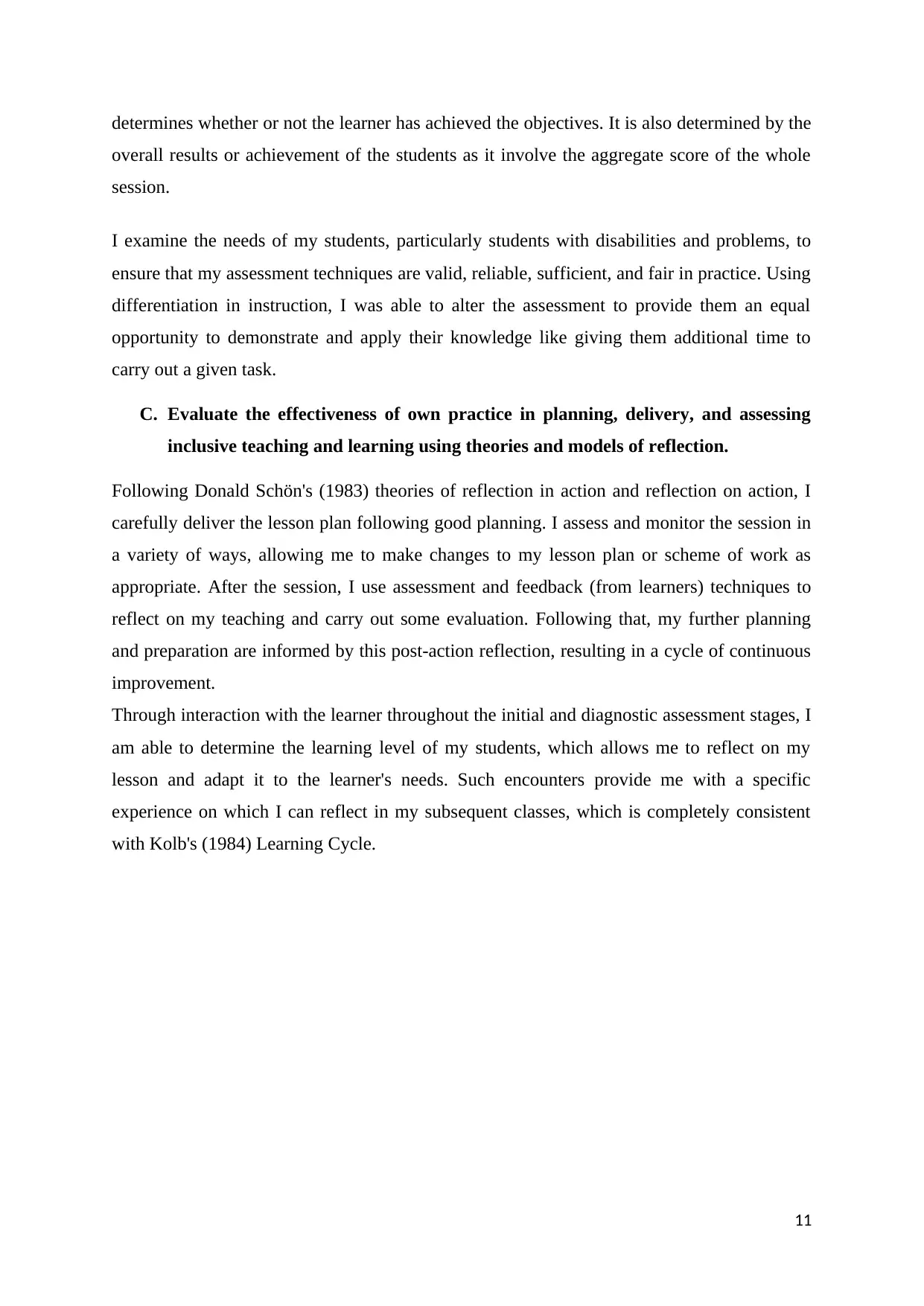
determines whether or not the learner has achieved the objectives. It is also determined by the
overall results or achievement of the students as it involve the aggregate score of the whole
session.
I examine the needs of my students, particularly students with disabilities and problems, to
ensure that my assessment techniques are valid, reliable, sufficient, and fair in practice. Using
differentiation in instruction, I was able to alter the assessment to provide them an equal
opportunity to demonstrate and apply their knowledge like giving them additional time to
carry out a given task.
C. Evaluate the effectiveness of own practice in planning, delivery, and assessing
inclusive teaching and learning using theories and models of reflection.
Following Donald Schön's (1983) theories of reflection in action and reflection on action, I
carefully deliver the lesson plan following good planning. I assess and monitor the session in
a variety of ways, allowing me to make changes to my lesson plan or scheme of work as
appropriate. After the session, I use assessment and feedback (from learners) techniques to
reflect on my teaching and carry out some evaluation. Following that, my further planning
and preparation are informed by this post-action reflection, resulting in a cycle of continuous
improvement.
Through interaction with the learner throughout the initial and diagnostic assessment stages, I
am able to determine the learning level of my students, which allows me to reflect on my
lesson and adapt it to the learner's needs. Such encounters provide me with a specific
experience on which I can reflect in my subsequent classes, which is completely consistent
with Kolb's (1984) Learning Cycle.
11
overall results or achievement of the students as it involve the aggregate score of the whole
session.
I examine the needs of my students, particularly students with disabilities and problems, to
ensure that my assessment techniques are valid, reliable, sufficient, and fair in practice. Using
differentiation in instruction, I was able to alter the assessment to provide them an equal
opportunity to demonstrate and apply their knowledge like giving them additional time to
carry out a given task.
C. Evaluate the effectiveness of own practice in planning, delivery, and assessing
inclusive teaching and learning using theories and models of reflection.
Following Donald Schön's (1983) theories of reflection in action and reflection on action, I
carefully deliver the lesson plan following good planning. I assess and monitor the session in
a variety of ways, allowing me to make changes to my lesson plan or scheme of work as
appropriate. After the session, I use assessment and feedback (from learners) techniques to
reflect on my teaching and carry out some evaluation. Following that, my further planning
and preparation are informed by this post-action reflection, resulting in a cycle of continuous
improvement.
Through interaction with the learner throughout the initial and diagnostic assessment stages, I
am able to determine the learning level of my students, which allows me to reflect on my
lesson and adapt it to the learner's needs. Such encounters provide me with a specific
experience on which I can reflect in my subsequent classes, which is completely consistent
with Kolb's (1984) Learning Cycle.
11
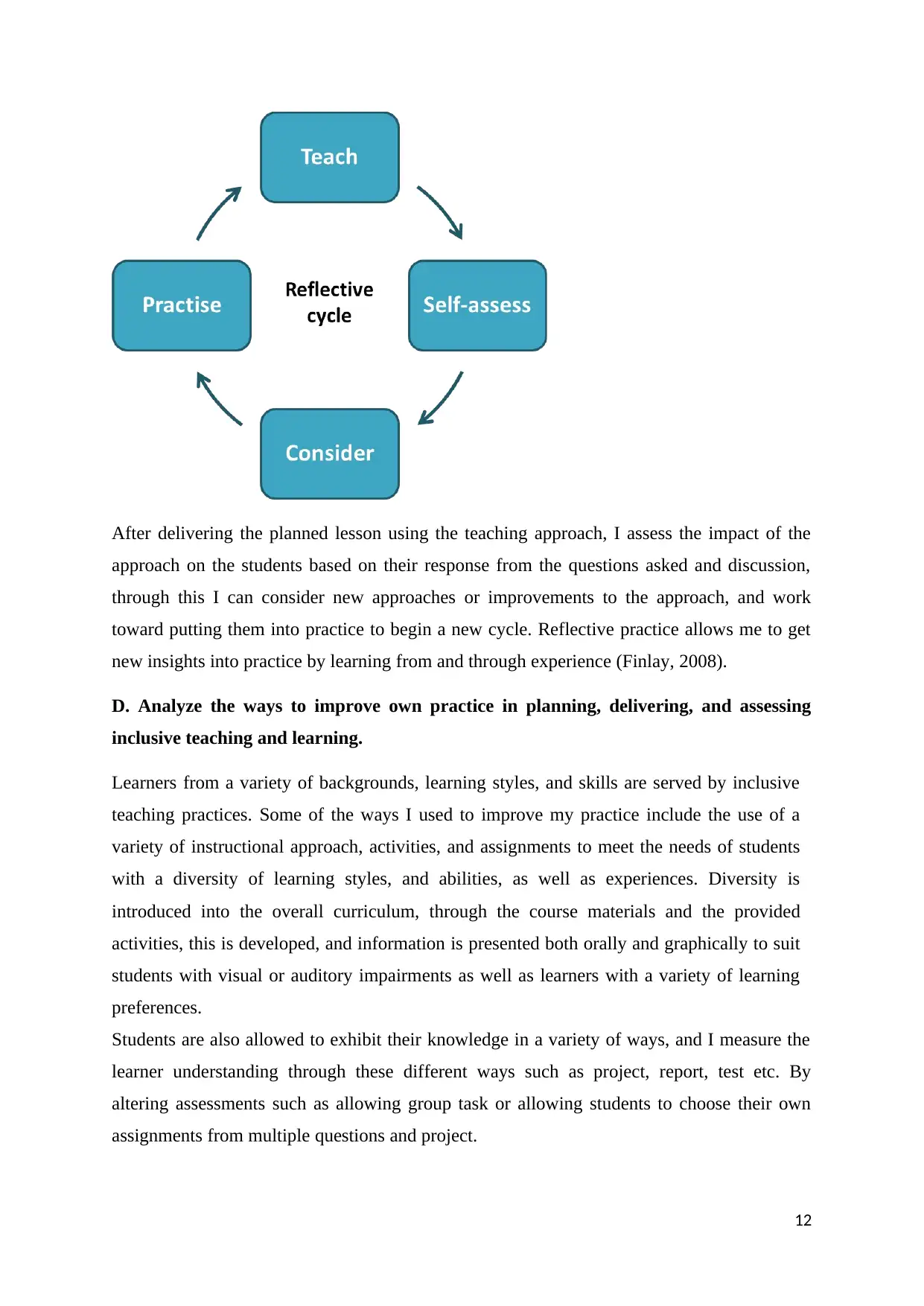
After delivering the planned lesson using the teaching approach, I assess the impact of the
approach on the students based on their response from the questions asked and discussion,
through this I can consider new approaches or improvements to the approach, and work
toward putting them into practice to begin a new cycle. Reflective practice allows me to get
new insights into practice by learning from and through experience (Finlay, 2008).
D. Analyze the ways to improve own practice in planning, delivering, and assessing
inclusive teaching and learning.
Learners from a variety of backgrounds, learning styles, and skills are served by inclusive
teaching practices. Some of the ways I used to improve my practice include the use of a
variety of instructional approach, activities, and assignments to meet the needs of students
with a diversity of learning styles, and abilities, as well as experiences. Diversity is
introduced into the overall curriculum, through the course materials and the provided
activities, this is developed, and information is presented both orally and graphically to suit
students with visual or auditory impairments as well as learners with a variety of learning
preferences.
Students are also allowed to exhibit their knowledge in a variety of ways, and I measure the
learner understanding through these different ways such as project, report, test etc. By
altering assessments such as allowing group task or allowing students to choose their own
assignments from multiple questions and project.
12
approach on the students based on their response from the questions asked and discussion,
through this I can consider new approaches or improvements to the approach, and work
toward putting them into practice to begin a new cycle. Reflective practice allows me to get
new insights into practice by learning from and through experience (Finlay, 2008).
D. Analyze the ways to improve own practice in planning, delivering, and assessing
inclusive teaching and learning.
Learners from a variety of backgrounds, learning styles, and skills are served by inclusive
teaching practices. Some of the ways I used to improve my practice include the use of a
variety of instructional approach, activities, and assignments to meet the needs of students
with a diversity of learning styles, and abilities, as well as experiences. Diversity is
introduced into the overall curriculum, through the course materials and the provided
activities, this is developed, and information is presented both orally and graphically to suit
students with visual or auditory impairments as well as learners with a variety of learning
preferences.
Students are also allowed to exhibit their knowledge in a variety of ways, and I measure the
learner understanding through these different ways such as project, report, test etc. By
altering assessments such as allowing group task or allowing students to choose their own
assignments from multiple questions and project.
12

13
Paraphrase This Document
Need a fresh take? Get an instant paraphrase of this document with our AI Paraphraser
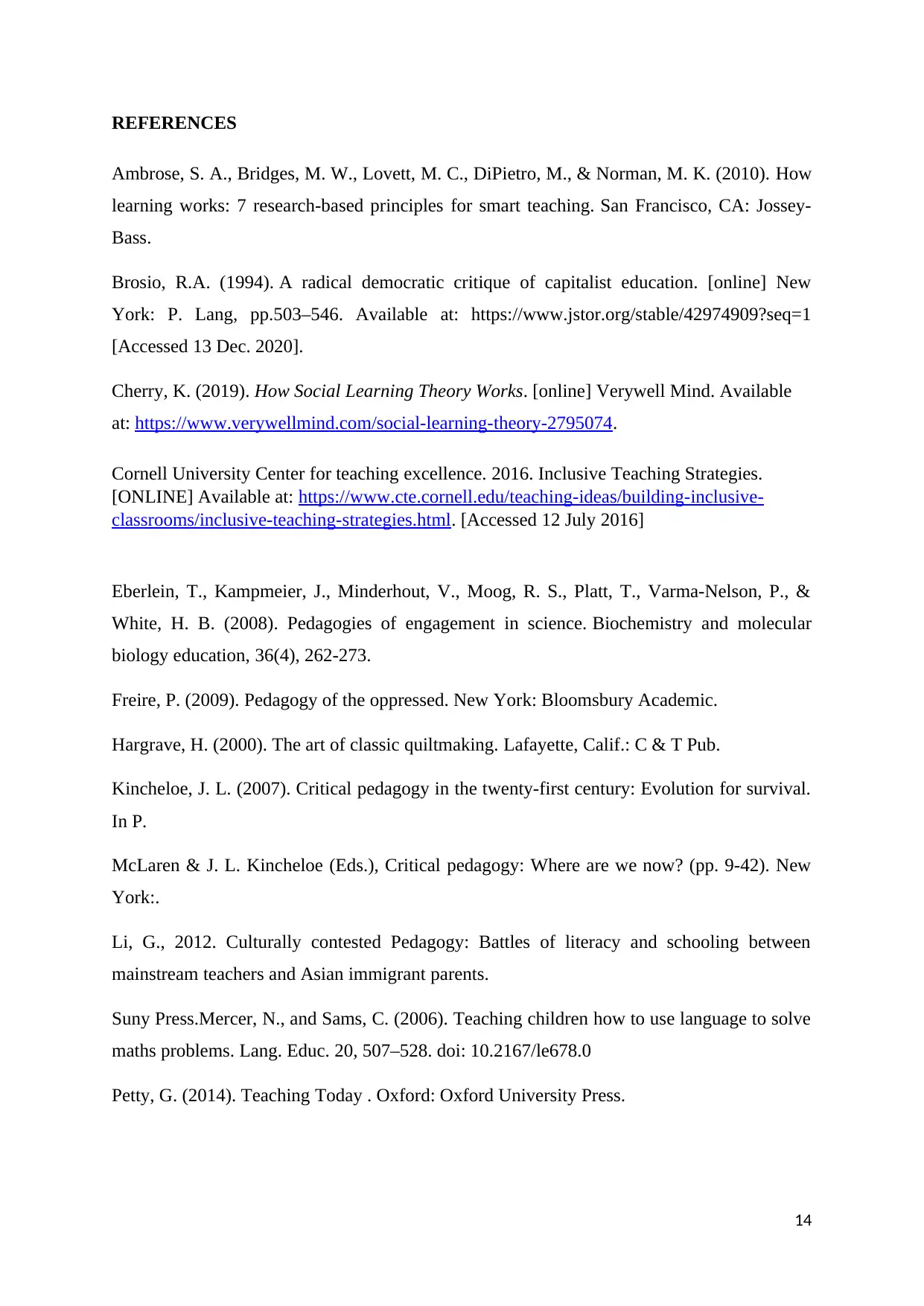
REFERENCES
Ambrose, S. A., Bridges, M. W., Lovett, M. C., DiPietro, M., & Norman, M. K. (2010). How
learning works: 7 research-based principles for smart teaching. San Francisco, CA: Jossey-
Bass.
Brosio, R.A. (1994). A radical democratic critique of capitalist education. [online] New
York: P. Lang, pp.503–546. Available at: https://www.jstor.org/stable/42974909?seq=1
[Accessed 13 Dec. 2020].
Cherry, K. (2019). How Social Learning Theory Works. [online] Verywell Mind. Available
at: https://www.verywellmind.com/social-learning-theory-2795074.
Cornell University Center for teaching excellence. 2016. Inclusive Teaching Strategies.
[ONLINE] Available at: https://www.cte.cornell.edu/teaching-ideas/building-inclusive-
classrooms/inclusive-teaching-strategies.html. [Accessed 12 July 2016]
Eberlein, T., Kampmeier, J., Minderhout, V., Moog, R. S., Platt, T., Varma‐Nelson, P., &
White, H. B. (2008). Pedagogies of engagement in science. Biochemistry and molecular
biology education, 36(4), 262-273.
Freire, P. (2009). Pedagogy of the oppressed. New York: Bloomsbury Academic.
Hargrave, H. (2000). The art of classic quiltmaking. Lafayette, Calif.: C & T Pub.
Kincheloe, J. L. (2007). Critical pedagogy in the twenty-first century: Evolution for survival.
In P.
McLaren & J. L. Kincheloe (Eds.), Critical pedagogy: Where are we now? (pp. 9-42). New
York:.
Li, G., 2012. Culturally contested Pedagogy: Battles of literacy and schooling between
mainstream teachers and Asian immigrant parents.
Suny Press.Mercer, N., and Sams, C. (2006). Teaching children how to use language to solve
maths problems. Lang. Educ. 20, 507–528. doi: 10.2167/le678.0
Petty, G. (2014). Teaching Today . Oxford: Oxford University Press.
14
Ambrose, S. A., Bridges, M. W., Lovett, M. C., DiPietro, M., & Norman, M. K. (2010). How
learning works: 7 research-based principles for smart teaching. San Francisco, CA: Jossey-
Bass.
Brosio, R.A. (1994). A radical democratic critique of capitalist education. [online] New
York: P. Lang, pp.503–546. Available at: https://www.jstor.org/stable/42974909?seq=1
[Accessed 13 Dec. 2020].
Cherry, K. (2019). How Social Learning Theory Works. [online] Verywell Mind. Available
at: https://www.verywellmind.com/social-learning-theory-2795074.
Cornell University Center for teaching excellence. 2016. Inclusive Teaching Strategies.
[ONLINE] Available at: https://www.cte.cornell.edu/teaching-ideas/building-inclusive-
classrooms/inclusive-teaching-strategies.html. [Accessed 12 July 2016]
Eberlein, T., Kampmeier, J., Minderhout, V., Moog, R. S., Platt, T., Varma‐Nelson, P., &
White, H. B. (2008). Pedagogies of engagement in science. Biochemistry and molecular
biology education, 36(4), 262-273.
Freire, P. (2009). Pedagogy of the oppressed. New York: Bloomsbury Academic.
Hargrave, H. (2000). The art of classic quiltmaking. Lafayette, Calif.: C & T Pub.
Kincheloe, J. L. (2007). Critical pedagogy in the twenty-first century: Evolution for survival.
In P.
McLaren & J. L. Kincheloe (Eds.), Critical pedagogy: Where are we now? (pp. 9-42). New
York:.
Li, G., 2012. Culturally contested Pedagogy: Battles of literacy and schooling between
mainstream teachers and Asian immigrant parents.
Suny Press.Mercer, N., and Sams, C. (2006). Teaching children how to use language to solve
maths problems. Lang. Educ. 20, 507–528. doi: 10.2167/le678.0
Petty, G. (2014). Teaching Today . Oxford: Oxford University Press.
14
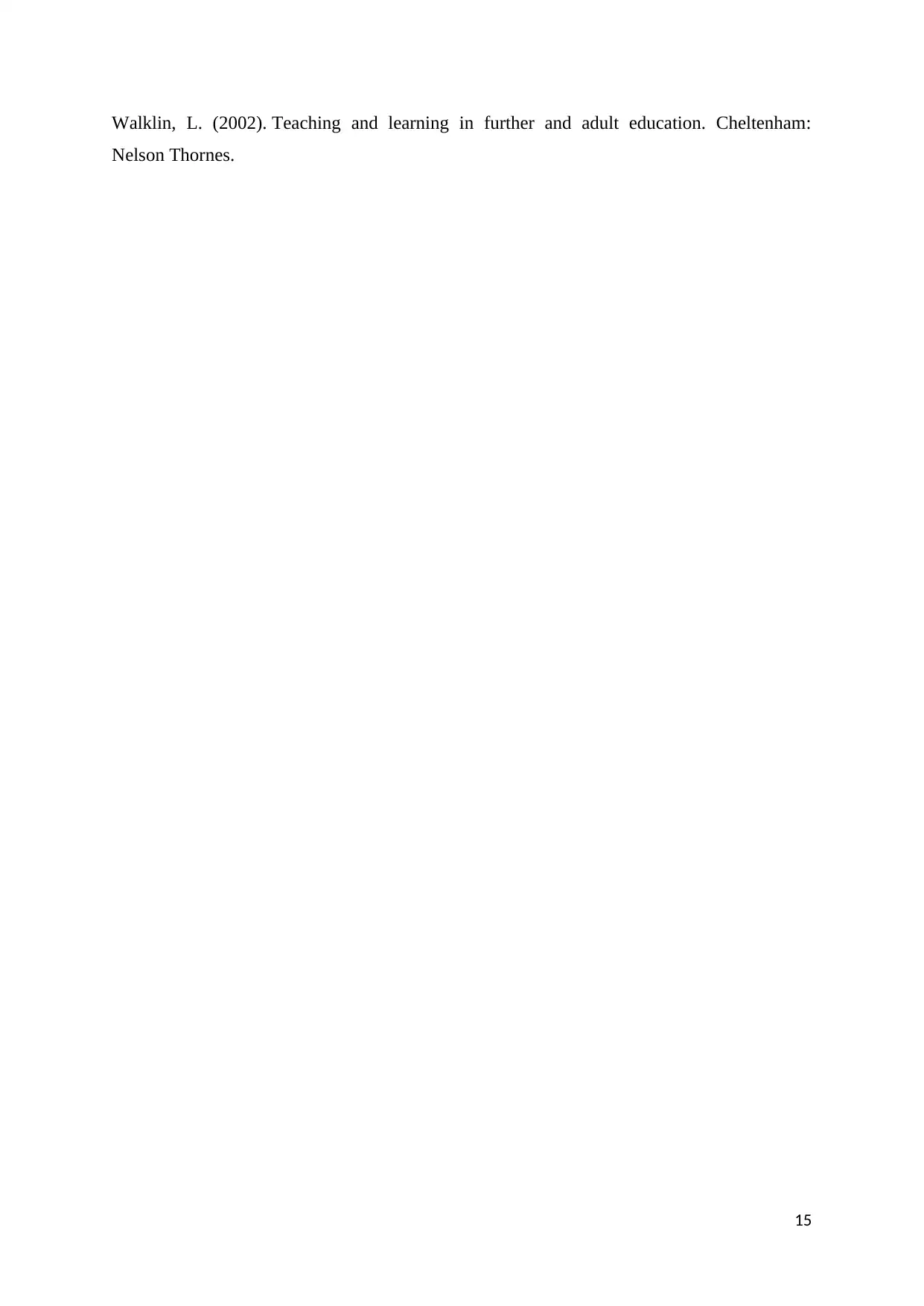
Walklin, L. (2002). Teaching and learning in further and adult education. Cheltenham:
Nelson Thornes.
15
Nelson Thornes.
15
1 out of 15
Related Documents
Your All-in-One AI-Powered Toolkit for Academic Success.
+13062052269
info@desklib.com
Available 24*7 on WhatsApp / Email
![[object Object]](/_next/static/media/star-bottom.7253800d.svg)
Unlock your academic potential
© 2024 | Zucol Services PVT LTD | All rights reserved.



